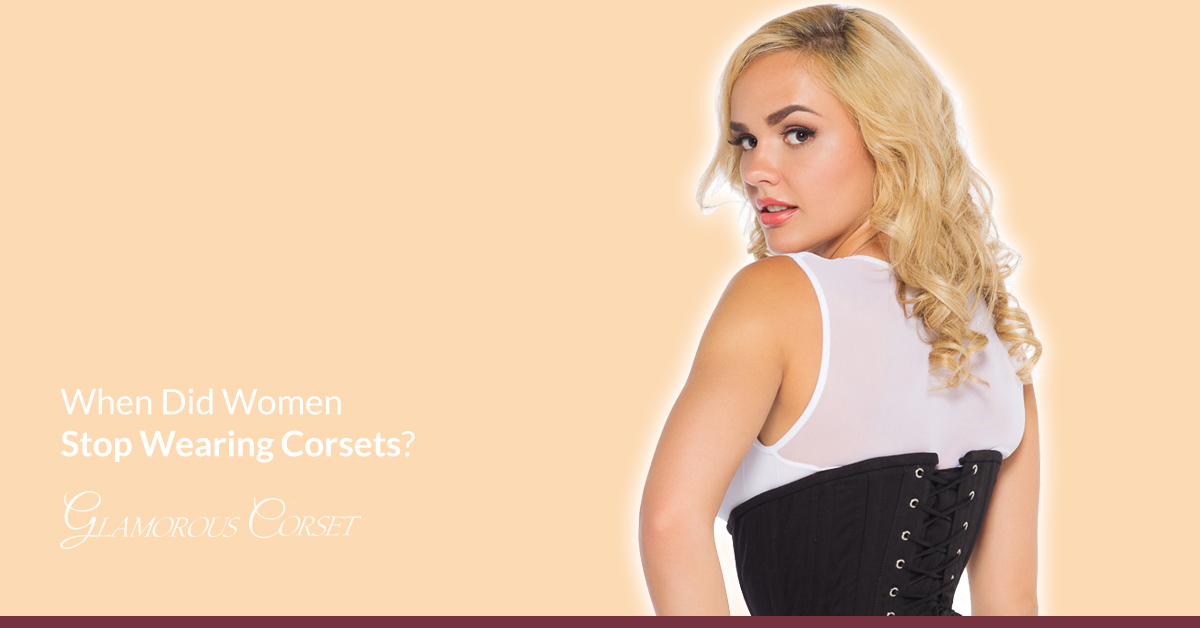Blog
When Did Women Stop Wearing Corsets?
Featured Corset: Jolie Black Cotton Corset
People who are unfamiliar with modern corset wear often assume that this style of undergarment went out with elaborate Victorian overskirts and bodices (not to mention barley curls and braided buns). In truth, the popularity of corsets did wane early in the 20th century.
One might assume this was because of the free-wheeling hedonism of the Roaring ‘20s, but the truth of fashion is almost always rooted in practicality. In this case, the decline of Victorian-era corset wear was spurred on by WWI material shortages that demanded simpler undergarments. Even so, corsets remained popular, albeit in newly streamlined and minimized formats.
So when did women stop wearing corsets? What most people don’t realize is that corsetry has never completely left the picture. Even as new forms of women’s undergarments emerged and fashion evolved to favor looser garments (along with an increased popularity of pants), there have always been women who were drawn to the benefits of corsets for slimming and shaping the silhouette.
In other words, women never stopped wearing corsets! Why do people think this long-lived garment is a thing of the past? Like many clothing styles, it wanes at certain times and enjoys a revival at others.
Here’s a brief look at the ups and downs of this often-popular undergarment throughout history.
The First Corsets
There’s no real way to know when the very first corsets came into being, but the earliest recorded history of such a garment appears to center on a sculpted figurine of a Minoan woman. Depicted holding two snakes, wearing an elaborate hat (topped with a cat) and flounced skirt, and sporting an underbust corset, this striking figure from Knossos, Crete, is dated to 1600 BCE, making it over 3,500 years old.
Arguably, this wasn’t even the first instance of garments resembling corsets — merely the first in recorded history. Historians speculate that the “girdle” portion of the outfit held some kind of ritual significance, perhaps related to Aphrodite’s magical girdle from Greek mythology, which was said to inspire passionate desires.
From Catherine de Medici to Coco Chanel
The rise in popularity of the cinched, laced garment that we today identify as the corset was said to start with Catherine de Medici, Queen Consort of France, during the 16th century. This powerful woman was infamous for her ruthless demeanor, but famed for her intellect and sense of style.
She is credited with popularizing a number of new styles during her time in the French court, including high heels (with platforms) designed to make her appear taller, long underwear meant for modesty when riding side-saddle, and corsets. It is rumored she forced a network of “femme fatale” spies to wear these in order to accentuate their figures.
She allegedly also banned “thick waists” in court, which led women of the aristocracy to wholeheartedly adopt the use of rigid corsets, a trend that quickly spread to nearby Spain and England.
When did women stop wearing corsets after the Middle Ages? They didn’t. For centuries, the trend continued, evolving with popular clothing styles of the time.
The 17th century saw the growth of an emphasis not just on small waists, but buxom décolletage, along with a significant increase in adornment to bodices, including decorative lacing, attached sleeves, and more.
In the 18th century, corsets began to feature long waists, narrow backs, and often, shoulder straps. The intention of these design alterations was to force the body into a more upright posture by drawing the shoulder blades together.
Under the reign of Queen Victoria in the 19th century, the goal of corsetry turned to creating smaller waistlines, a look made even more dramatic by the bell-shaped skirts that were popular at the time.
This continued until about the turn of the century, when fluted skirts replaced the bell shape and more attention was paid to pronounced bustles. This served to create the small-waisted, S-shaped silhouette embodied by the famous Gibson Girl.
As noted above, the shortages of WWI led to significant changes in the landscape of women’s undergarments. A boyish physique was essential for proper drape of the drop-waist dresses of the time, so undergarments pivoted to minimize the hip and thigh area, creating a straighter line down the body.
Around this time, Coco Chanel famously eschewed corsets and kicked off a trend of women wearing pants for comfort and ease of movement.
Fabric shortages struck again during WWII, and when the world emerged, style sensibilities had changed somewhat, leaning toward separates for undergarments, such as brassieres and girdles.
The production of long latex fibers for clothing began as early as the 1930s, but it didn’t become a common addition to girdles until the ‘50s, when lacing went out of fashion. The following decades saw a growing selection of undergarments for women, but corsets never truly went away.
When Did Women Stop Wearing Corsets in the Modern Era?
While corsets were certainly not as popular in the ‘60s, ‘70s, and ‘80s as they were in previous decades and centuries, they made a comeback in the ‘90s, thanks largely to one woman. When Madonna started wearing Jean Paul Gaultier corsets for her stage shows, she rekindled the romance with these feminine garments.
Today, women wear corsets not because fashion dictates their necessity, but because they want to slim their waists, support their body, perfect the drape of clothing, and look and feel their best every day. The use of corsets may ebb and flow throughout history, but they’re just as valued for form and function as they were 3,500 years ago.
To stay up-to-date with weekly blog posts, waist training tips, and the chance to win one of our monthly corset giveaways, follow us on Facebook, Instagram & subscribe to our mailing list today! Want to find the perfect steel boned corset? Shop some of our favorites: underbust corsets, overbust corsets, corset dresses. You can also shop our corsets by material: cotton corsets, denim corsets, leather corsets, mesh corsets, pvc corsets, and satin corsets. Have questions about getting started with waist training or finding the right size corset? Contact us!

My name is Rachel, I am the owner of Glamorous Corset, a small business founded by me in 2010. Back In 2005, I was in a car accident that left me with a herniated disk. Much to my surprise I learned steel boned corsets were beneficial to several medical injuries including mine. I was always intrigued with corsetry, their history and their beautiful aesthetic. I love sharing knowledge about corsets, educating my wonderful readers and breaking the negative stigma related to corsetry. In combination with my years of research and personal experience I hope my articles are useful and can help anyone who has struggled with some of the same things I have. More about me…


